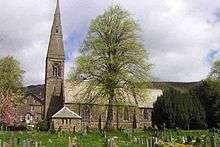Bamford Church
| St John the Baptist church | |
|---|---|
 St John the Baptist | |
 Shown within Derbyshire | |
| Basic information | |
| Location | Bamford |
| Geographic coordinates | 53°20′53″N 1°41′37″W / 53.34800°N 1.69352°WCoordinates: 53°20′53″N 1°41′37″W / 53.34800°N 1.69352°W |
| Affiliation | Anglican |
| District | Diocese of Derby |
| Ecclesiastical or organizational status | Parish church |
| Architectural description | |
| Architectural type | Church |
| Completed | 1861 |
St John the Baptist church is a C of E church in Bamford in the Hope Valley, Derbyshire, England. The building that is seen today is largely a William Butterfield restoration dating from 1861, with a bell tower.
The Bells and Tower
The tower has six ringable bells, cast in 1998 to mark the Millennium. They replaced a peal from 1886. The modern bells have sprung metal stays instead of wooden ones. The Treble weighs 1 hundredweight (50 kg). The bellringers practice on Wednesdays. [1]
The Churchyard
Exhumations from the cemetery of the village of Derwent were re-interred in St John's churchyard after the construction of the Ladybower Dam submerged that village during the Second World War.[2] Also in the graveyard is a grave marking the dead from Tin Town (Birchinlee), a temporary village made to house the workers who built the Derwent and the Howden dams in 1902. There is also a memorial for the dead of the Holocaust. The churchyard contains war graves from World War I of two male soldiers, a female member of Queen Mary's Army Auxiliary Corps and a Royal Air Force airman.[3]
Location
Main Road, Bamford, Hope Valley, Derbyshire, England, UK
Opposite St John's Close
See also
References
- ↑ Julie Bunting/Peak Advertiser. "Church Bells".
- ↑ Francis Frith. "Bamford".
- ↑ CWGC Cemetery Report, details from casualty record.